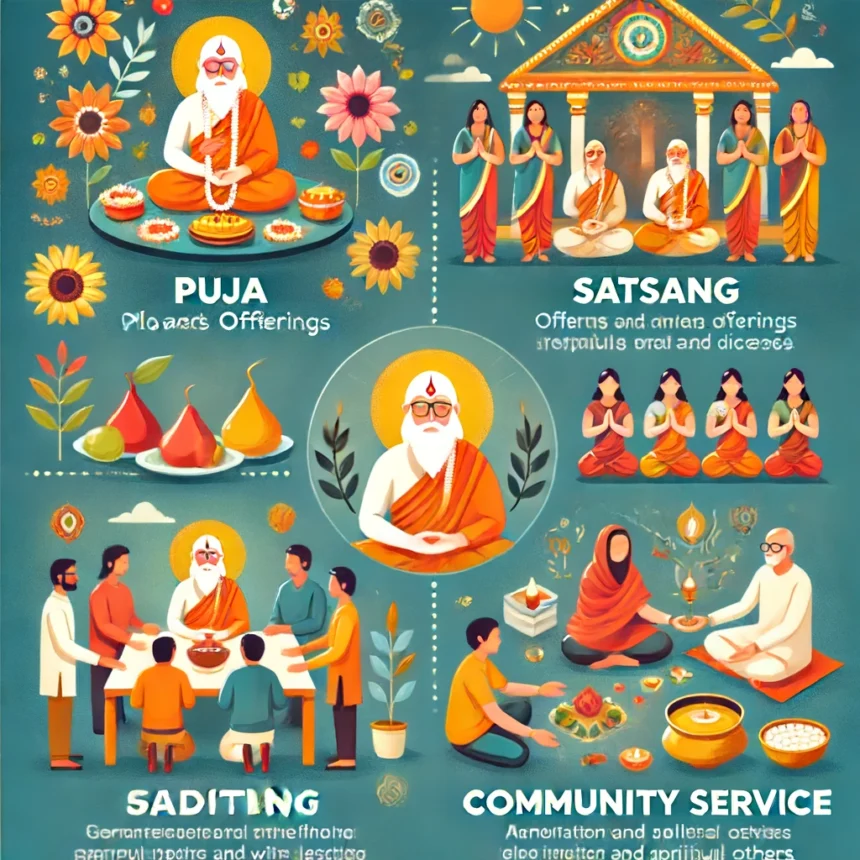Celebrating the Revered Teacher-Student Tradition
Introduction To Guru Purnima
Welcome to another installment of our weekly blog series on HinduInfoPedia.org. As part of our Saturday theme—Education and Learning—we explore significant festivals and their educational and spiritual significance within Hinduism. This Saturday, June 1, 2024, we delve into the festival of Guru Purnima, a day dedicated to honoring Gurus and the sacred Guru Shishya Parampara.
Guru Purnima, also known as Vyasa Purnima, is a revered festival celebrated by Hindus, Buddhists, and Jains to honor their spiritual and academic teachers. The festival falls on the full moon day (Purnima) in the Hindu month of Ashadha (June-July). It is a day of gratitude and reverence, marking the importance of the Guru in one’s life and the enduring legacy of the Guru Shishya tradition.
Historical and Spiritual Context of Guru Purnima
The origin of Guru Purnima dates back to ancient times and is linked to several significant figures in Hinduism. It is traditionally observed as the birth anniversary of Sage Vyasa, the author of the Mahabharata and a revered Guru who played a crucial role in preserving Vedic knowledge. Hence, it is also known as Vyasa Purnima.
Bhagwan Vyasa, also known as Vedavyasa or Krishna Dvaipayana Vyasa, is attributed with compiling and composing numerous sacred texts that are foundational to Hindu philosophy and practice. Among his most revered works are the Mahabharata, one of the longest epic poems in the world; the Puranas, a genre of ancient texts that include myths, legends, and traditional lore; and the Brahma Sutras, which are key texts of the Vedanta school of Hindu philosophy. Sage Vyasa is also credited with organizing the Vedas into four parts—Rigveda, Samaveda, Yajurveda, and Atharvaveda—thereby preserving and systematizing these essential scriptures. His contributions have been instrumental in shaping the spiritual and philosophical landscape of Hinduism.
In the Buddhist tradition, Guru Purnima commemorates the day when Lord Buddha gave his first sermon at Sarnath after attaining enlightenment. This highlights the festival’s universal appeal across different spiritual traditions, emphasizing the role of the Guru in imparting wisdom and guiding disciples on the path to enlightenment.
Significance of Guru Purnima
Guru Purnima is a day of profound introspection and renewal for students and disciples, serving as a pivotal moment to honor the invaluable contributions of their Gurus. It provides an opportunity to reflect deeply on the teachings received over the past year, assessing the progress made in one’s spiritual and personal journey. This festival is not just a day of celebration but a reminder of the continuous path of learning and self-improvement that lies ahead.
The festival underscores the essence of the Guru Shishya Parampara, reinforcing the sacred bond between the Guru and the disciple. This relationship is foundational in Hinduism, as it facilitates the transmission of wisdom, ethical values, and spiritual insights from the Guru to the Shishya. On this auspicious day, disciples express their heartfelt gratitude and reverence towards their Gurus through various rituals and ceremonies. These acts of devotion include reciting scriptures, performing pujas (rituals), and participating in satsangs (spiritual gatherings). Such activities not only honor the Guru but also rejuvenate the spiritual commitment of the disciples.
Moreover, Guru Purnima is a time when Gurus impart special teachings and blessings, offering guidance that inspires their disciples to strive for higher knowledge and spiritual growth. The unique interaction between the Guru and the disciple on this day reinforces the importance of continuous learning and the pursuit of spiritual enlightenment. It is a reminder that the journey of knowledge is ongoing, and the Guru’s guidance is pivotal in navigating this path.
Celebrations on Guru Purnima

The celebrations of Guru Purnima are marked by various traditional rituals and activities that highlight the reverence and devotion of disciples towards their Gurus. These activities are designed to express gratitude, reflect on teachings, and engage in acts of service and devotion.
- Puja and Offerings: Disciples perform special pujas to honor their Gurus, offering flowers, fruits, and other gifts as tokens of respect and gratitude. The puja rituals are often elaborate, involving the recitation of sacred mantras and the singing of hymns that praise the Guru’s wisdom and compassion. These offerings symbolize the disciple’s devotion and the acknowledgement of the Guru’s role in their spiritual journey.
- Satsang and Discourses: Many spiritual organizations and ashrams organize satsangs and discourses, where Gurus impart wisdom and spiritual teachings to large gatherings of disciples. These sessions are highly enriching, providing an opportunity for disciples to gain deeper insights into spiritual doctrines and practices. The collective energy of satsang fosters a sense of community and shared spiritual purpose, enhancing the overall experience of Guru Purnima.
- Meditation and Reflection: Disciples spend the day in meditation and reflection, contemplating the teachings of their Gurus and seeking to internalize them. This period of quiet introspection allows disciples to connect more deeply with the teachings, fostering a sense of inner peace and clarity. Meditation sessions are often guided by the Guru, helping disciples to focus their minds and deepen their spiritual practice.
- Community Service: Reflecting the Guru’s teachings on selflessness and compassion, some communities engage in acts of charity and service. These activities may include distributing food to the needy, organizing health camps, or participating in environmental conservation efforts. Community service on Guru Purnima underscores the practical application of the Guru’s teachings, highlighting the importance of altruism and social responsibility.
Overall, the celebrations and rituals of Guru Purnima serve to reinforce the spiritual bond between Guru and disciple, promote personal reflection, and encourage acts of compassion and service. This holistic approach to the festival ensures that it is a day of both spiritual renewal and practical action, embodying the teachings of the Guru in every aspect of life.
Modern Relevance of Guru Purnima
In contemporary times, Guru Purnima has adapted to include virtual celebrations, allowing disciples from around the world to connect with their Gurus through online platforms. This evolution underscores the festival’s enduring relevance and its ability to transcend geographical boundaries, making it accessible to a global audience. Despite these technological advancements, the core values of Guru Purnima remain unchanged, serving as a powerful reminder of the timeless significance of the Guru Shishya Parampara in our lives.
However, the modern relevance of Guru Purnima also brings into sharp focus the challenges faced by the traditional education system in India. The commercialization of education, particularly since the implementation of the Indian Education Act of 1835, has fundamentally altered the teacher-student relationship. This act, revered by many Indian politicians to this day, laid the groundwork for a more westernized, commercialized education system that prioritized financial gain over the holistic development of students.
As a result, both teachers and students have lost a significant degree of mutual respect. The traditional reverence for teachers, once a cornerstone of Hindu culture, has eroded, replaced by a transactional dynamic driven by market forces. This shift is also attributable to the loss of the basic Hindu cultural practice of donations for education. In the past, the teaching community survived on alms and were content with whatever they received. This system not only ensured the teacher’s material needs were met but also fostered a culture of humility and relinquishment of material wealth.
In stark contrast, modern educators often have to fight for their livelihoods, struggling to secure adequate pay and resources. This material struggle has diminished the noble stature of the teaching profession, reducing the ability of teachers to focus purely on imparting knowledge and values. The societal respect and honor that were once inherently granted to teachers are now largely absent, contributing to a general decline in the quality of education and the moral fabric of society.
Guru Purnima serves as a poignant reminder of these lost values, urging a return to the fundamental principles of the Guru Shishya Parampara. It encourages us to honor and uphold the teachings of our Gurus, fostering a sense of humility, gratitude, and continuous learning. By reflecting on the original ethos of the Guru-disciple relationship, we can aspire to restore the respect and reverence that are essential for true educational and spiritual growth.
In celebrating Guru Purnima, we are reminded not only of the spiritual and educational wisdom imparted by our Gurus but also of the broader cultural and societal values that underpin this sacred tradition. It is a call to action to revitalize these principles in our contemporary educational practices, ensuring that the legacy of the Guru Shishya Parampara continues to inspire and guide future generations.
Global Perspective on Guru Purnima Celebrations
Guru Purnima’s significance transcends geographical boundaries, embraced by diverse communities across the globe. This global observance reflects the universal values of reverence for teachers and the pursuit of spiritual wisdom. In countries like the United States, Canada, the United Kingdom, and Australia, where large Indian diaspora communities reside, Guru Purnima is celebrated with much fervor. These celebrations often include gatherings at local temples, cultural centers, and, increasingly, online platforms that accommodate those unable to attend in person.
Virtual celebrations, in particular, have allowed disciples from remote parts of the world to participate in Guru Purnima festivities. These digital gatherings often feature live-streamed rituals, online satsangs, and interactive discourses with Gurus. This adaptation not only maintains the tradition but also introduces it to a broader audience, demonstrating the adaptability and enduring appeal of this ancient festival.
Moreover, Guru Purnima has found resonance beyond the Indian communities, appealing to anyone who values spiritual learning and mentorship. Various yoga and meditation centers globally now observe Guru Purnima, where instructors are honored and the teachings of yoga philosophy are highlighted. This inclusivity enriches the celebration, making Guru Purnima a truly global festival that fosters a deeper understanding and appreciation of the Guru-disciple relationship.
Reflections on Guru Purnima
As we celebrate Guru Purnima, let us reflect on the profound impact of our Gurus and the enduring legacy of the Guru Shishya Parampara. This festival not only honors the contributions of our spiritual and academic teachers but also inspires us to embody their teachings in our daily lives.
Join us next Saturday on HinduInfoPedia.org as we continue our exploration of the rich educational and cultural heritage of Hinduism. May the blessings of our Gurus guide us on the path of wisdom and enlightenment.
Feature Image: Click here to view the image.
#GuruPurnima #GuruShishyaParampara #SpiritualWisdom #HinduFestivals #VedicKnowledge
Posts
Guru Shishya Parampara: Preserving the Sacred Relationship



Leave a Reply